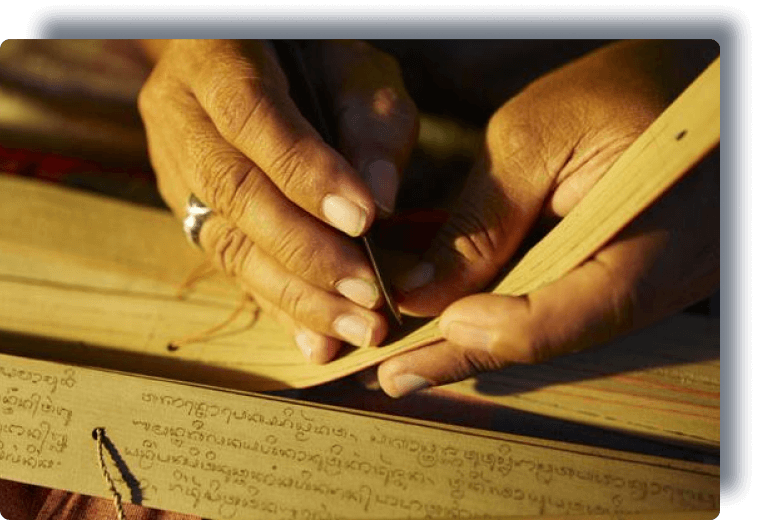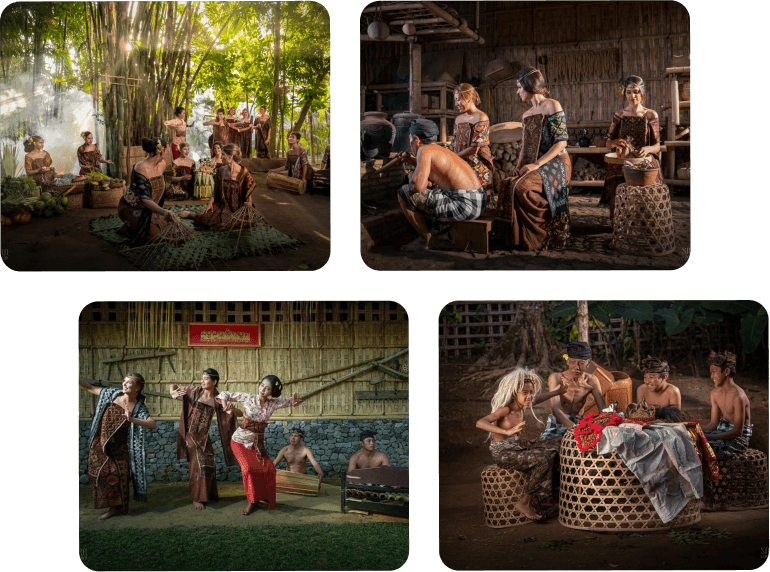
Great Experience
You’ll get the unforgettable
and best experience.

Satisfaction
In every trip includes insurance. So don’t worry.

CHSE Certificated
Clean, Healthy, Safe and Environmentally
About Us
Explorer All Corners of the world with us
We will show you how beautiful the world is and make you happy to see it, what a heaven on earth
Culture and Heritage
Living Museum Concept
It can be interpreted as the daily life of the Karangasem people who still interact and practice the values contained in traditions, rituals and cultures that have been handed down from generation to generation by their ancestors as meaning for the values of Balinese human life.This is not limited to ritual ceremonies and traditions of the Karangasem community, but also includes material and intangible cultural heritage, preservation and conservation of artistic culture, including artifacts and philosophical meanings contained in each of these ritual, traditional and cultural activities.
Samsara Living Museum

Samsara Museum is a living museum. A warm and open space that will guide any visitors to enjoy and experience the beauty, wealth and to celebrate the cultural values inherited from our ancestors and presents them through love and joy.
Sanghyang Dedari Museum

Sang Hyang Dedari as a rite can be traced back to ancient times Balinese, where rice was considered sacred. The dance is a form of gratitude to the gods and goddesses, but it is also a prayer for a successful crop, healthy crops, protection from rice pests and other kinds of problems.
Tenganan Pegringsingan

This village is much referred by cultural literature science of Tenganan Pegringsingan, which is very famous in the island. It own very unique local community life pattern which is one example of Bali Aga Village cultures (Hindu Prehistoric) and different with other countryside in plain of Bali.
Pustaka Lontar Museum

The Balinese view lontar as sacred, carrying traditional knowledge from culinary practices, medicine, agriculture, religious and economic systems to arts, language, and more that all serve as a guidance to conduct one’s life. There are nine categories of lontar in total.
Samsara Living Museum
Samsara Museum is a living museum. A warm and open space that will guide any visitors to enjoy and experience the beauty, wealth and to celebrate the cultural values inherited from our ancestors and presents them through love and joy. Samsara is one of the beliefs of Hindus, particularly in the Island of God. It is about the stages of life, characterized by various ceremonies and traditional rituals that lead to the belief in the task of living as humans in repeated births to perfection.Located in Jungutan village of Karangasem district in Bali, in an area of two hectares of green and calming nature. The energy of the universe is abundant, so many lessons can be learned and remembered. Visitors who come here will gain valuable experience and knowledge on various rituals in the Balinese life cycle. There is an introduction to various ceremonies along with the supporting tools and accessories as well as the meaning behind each existing symbol.
Gallery
The Circle of Balinese Life
The Living Museum Ecosystem
Sajeng Living Museum
Twalen is a spirit of togetherness that places human, nature, and the sacred rites in foremost. All three have strong ties to maintain the existence and sustainability of Twalen which leads to shared prosperity, cultural resistance and a well-maintained ecosystem.
Gallery
Twalen Spirit
The Living Museum Ecosystem
Sanghyang Dedari Museum
This research and community engagement investigates an ancient Balinese ritual known as Sang Hyang Dedari. The dance is interrelated to an agricultural aspect of the traditional Balinese living. As the Balinese struggle to maintain their values from the constant threat of modernization and industrialization, this dance reveals the powerful impact of creating an awareness of socio-ecological equilibrium. The effort made by the villagers of Geriana Kauh, Karangasem, displays how local community rebuilds its environment based on their traditional ecological value.Analyzing Sang Hyang Dedari dance through phenomenological approach, thus, it can be discovered how the ritual sustains the social relations. The bodies of the dancers are the center of an elaborate nexus between people, nature and god. To understand how the dualism of sacred and profane bodies, this research utilizes the body theory by Maurice Merleau-Ponty. The importance of phenomenology as a theory relates to the understanding on how the ritual works as an event in its totality. Understanding the unity between the presence of the divine, nature and human. The output of this research and community engagement is a museum built in cooperation between University of Indonesia with the villagers of Geriana Kauh, Karangasem.As the performance and knowledge about Sang Hyang Dedari appeared to be scarce, this museum is a form of collaboration to retrace the history of Sang Hyang Dedari ritual, in an attempt to conserve the ancient knowledge. Sang Hyang Dedari as a rite can be traced back to ancient times Balinese, where rice was considered sacred. The dance is a form of gratitude to the gods and goddesses, but it is also a prayer for a successful crop, healthy crops, protection from rice pests and other kinds of problems.
Gallery
Culture and Ritual
The Living Museum Ecosystem
Tenganan Pegringsingan
This village is much referred by cultural literature science of Tenganan Pegringsingan, which is very famous in the island. It own very unique local community life pattern which is one example of Bali Aga Village cultures (Hindu Prehistoric) and different with other countryside in plain of Bali.Located at northwest of Candidasa, is situated about 5 km from the main road. Tenganan is a symmetrically laid out Bali Ada village with a walled homes and unique crafts. The Tenganan villages is one of the ancient villages on the island of Bali. It reflects the cultural life of its people and customes of the Bali Aga Village which was different from other villages in Bali. Therefore the Tenganan Village developed as a popular cultural tourist attraction.
Gallery
The Beauty of Bali
The Living Museum Ecosystem
Pustaka Lontar Museum
Museum Pustaka Lontar was officially inaugurated in November 2017, acknowledged by lontar maestro Ida I Dewa Gede Catra and Dutch lontar researcher Professor Hinzler, who additionally acts as one of the museum’s curators.The museum is a series of traditional Balinese buildings dotting over one and a half hectares of highlands in east Bali, enveloped in rolling hills and overlooking fields of green. The village in which the museum if found is locally loved for their lawar jepun, a traditional Balinese dish of minced meat sautéed with vegetables, coconut shavings and herbs. The limited livestock in the district refashioned the popular fare into a plant-based delicacy, using frangipani leaves (jepun) instead of meat.The Balinese view lontar as sacred, carrying traditional knowledge from culinary practices, medicine, agriculture, religious and economic systems to arts, language, and more that all serve as a guidance to conduct one’s life. There are nine categories of lontar in total. Proper care of these items is thus vital for the passing down of generational wisdom. But not all lontars are great in value. The lineup of lontars hung at the museum’s Bale Sang Kul Putih, the centre point of the museum, are everyday notes, not unlike the mundane grocery lists on fridges, or reminders of payable debts, from which you can identify the leaves— dry and written to be eventually disposed of.
Gallery
Traditional Knowledge
The Living Museum Ecosystem
Puri Agung Karangasem
The Puri Agung Karangasem royal palace dates to the 19th century, during the reign of Anak Agung Agung Anglurah Ketut Karangasem. The palace is a silent witness to pretty much the whole span of Bali’s history – from the times of the Majapahit Empire to the refuge from Islam, the breaking down of Bali’s realms into 9 kingdoms, the Dutch occupation and its defeat, through to the formation and declaration of Indonesia’s independence.Many of the historical buildings are intact, retaining much of its past glory with hints of Balinese, Chinese, and European architectural details. There’s even a ‘floating’ Gili pavilion surrounded by a lotus-filled moat. The different palatial clusters, particularly within the main site of the Puri Agung complex, used to house the late Raja’s royal court. Today, it’s still used for royal ceremonies and private events of the extended royal family.
Gallery
Royal Palace
The Living Museum Ecosystem
About Us
Karangasem Living Museum
We will show you how beautiful the world is and make you happy to see it, what a heaven on earth
Culture and Heritage
It can be interpreted as the daily life of the Karangasem people who still interact and practice the values contained in traditions, rituals and cultures that have been handed down from generation to generation by their ancestors as meaning for the values of Balinese human life.This is not limited to ritual ceremonies and traditions of the Karangasem community, but also includes material and intangible cultural heritage, preservation and conservation of artistic culture, including artifacts and philosophical meanings contained in each of these ritual, traditional and cultural activities.
Vision
The depiction of the process and cycle of human life and death that takes place continuously as a life cycle full of philosophy, value and meaning as learning.
Mision
The existence of the Museum of Life is an effort to preserve, conserve, and transform science for Balinese human values as a reflection and actualization of the value of the nature of life.















































